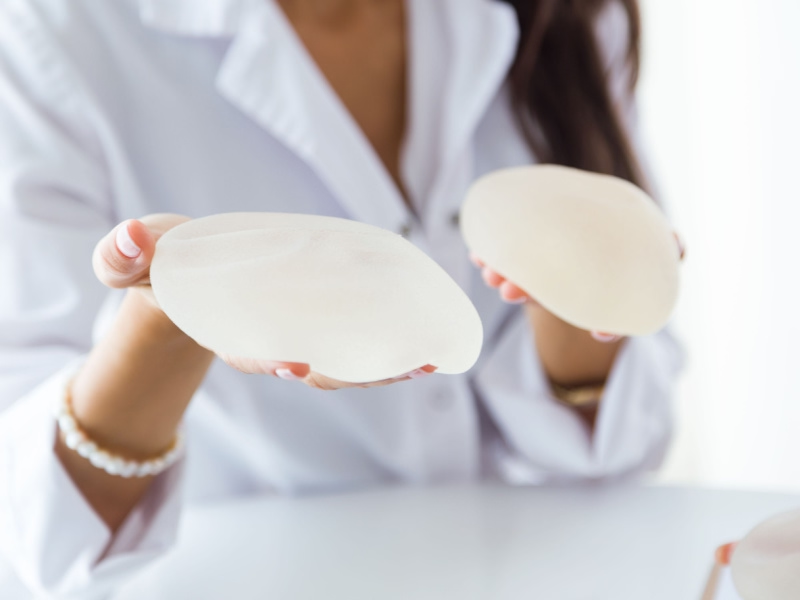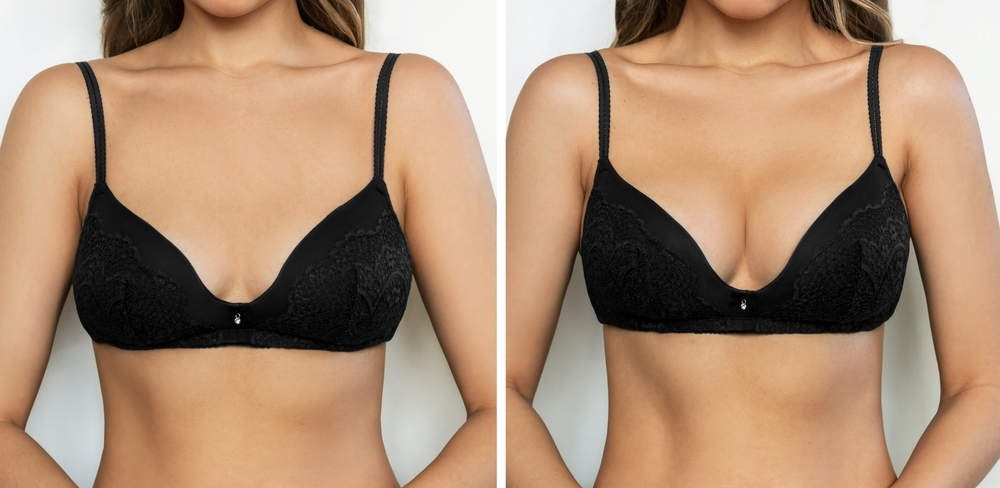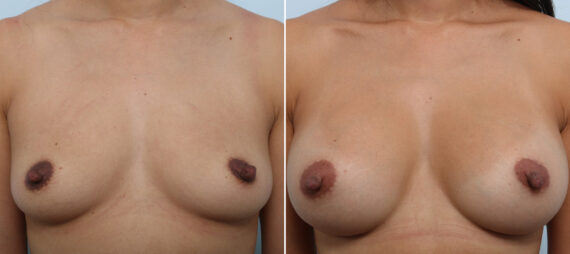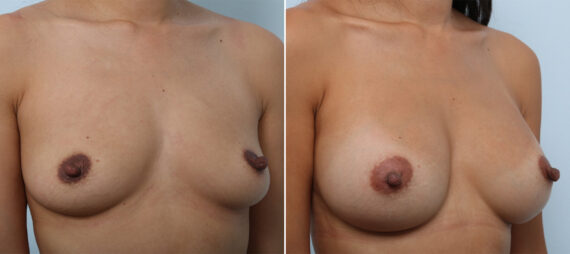Breast augmentation is an effective cosmetic surgery solution for women seeking to enhance their breast size and shape. Fat transfer and breast implant surgery are two breast augmentation procedures with unique advantages and considerations. The choice often depends on the individual’s aesthetic goals, body type, and personal preferences.

Breast Augmentation Choices
Fat transfer, a natural breast augmentation method, uses the patient’s body fat, which is extracted through liposuction for modest breast enhancement and body contouring.
Augmentation with implants involves inserting saline or silicone devices beneath the natural breast tissue or chest muscle.
Fat Transfer in Breast Augmentation
Fat transfer breast augmentation has gained popularity in recent years due to its natural results and dual benefit of contouring the donor site from where the fat is harvested.
How Fat Transfer Works
Fat transfer in breast augmentation, or autologous fat transfer, begins with liposuction to extract excess body fat from areas like the abdomen, thighs, or flanks. The harvested fat is then purified to separate healthy fat cells, reducing the risk of cell death and increasing graft success.
The purified fat is placed into syringes and carefully injected into the breast tissue at various depths for an even, natural-looking result. This controlled process prevents over-injection and ensures even dispersion within the natural breast tissue and adipose layers.
Advantages of Fat Transfer
One of the main advantages of fat transfer is that it provides a more natural and softer appearance compared to implants. Since the procedure uses the patient’s own body fat, there’s virtually no risk of rejection or allergic reaction.
The Enduring Appeal of Breast Implants
Despite the rising popularity of fat transfer procedures, breast implants remain a popular choice for many women seeking breast augmentation.
Types of Implants
Breast implants are artificial devices that come in different types, primarily saline and silicone. Saline implants contain a sterile saltwater solution, whereas silicone ones have a viscous silicone gel inside. Both types of implants come in various sizes and shapes.
Why Women Choose Implants
Breast implants offer a reliable and predictable increase in breast size. They allow for a greater choice in size and shape compared to fat transfer. Most patients can have an implant. Not all patients are eligible for a fat transfer.

Comparing the Strategies for Breast Augmentation
When comparing fat transfer and implants for breast augmentation, several factors come into play, including cost, longevity, and maintenance.
Cost Comparison
Fat transfer’s complexity, from fat extraction to breast tissue injection, makes it pricier than breast implants. Potential fat reabsorption may necessitate additional sessions, raising the total cost.
Breast implant surgery, which includes the cost of saline or silicone implants, surgical treatment, implant placement under natural breast tissue or chest muscle, and incision type, is generally less expensive.
Longevity and Maintenance
Fat transfer and implants differ in longevity and maintenance. Fat transfer outcomes can be unpredictable, as sometimes there is fat reabsorption that decreases breast size over time.
Breast implants provide more dependable, enduring results, but may need replacement or adjustment due to complications or aging.
Safety Concerns in Fat Transfer and Implants
Over-injection in fat transfers may lead to an unnatural look or scar distortion. Also, uneven fat reabsorption can cause asymmetrical breasts or breast reduction.
There is also a slight risk of fat necrosis, which can cause firm lumps and possibly require additional treatment or breast reconstruction.
Alternatively, saline or silicone breast implants offer a substantial size increase but carry risks such as implant rupture, and capsular contracture. In rare cases, breast implant illness with symptoms like fatigue and memory loss.
The Aesthetic Differences Between Fat Transfer and Breast Implants
The aesthetic outcomes of fat transfer and breast implants can be significantly different, depending on the patient’s goals and preferences.
Natural Look vs. Enhanced Look
Fat transfer merges with natural breast tissue, providing a 1-2 cup size increase. It’s perfect for those who want natural breast augmentation with a modest volume increase or for rectifying uneven breasts.
Breast implants, filled with saline or silicone gel within a silicone shell, offer substantial enhancement and larger breasts. Silicone implants mimic natural breasts, while saline ones are favored for their safety upon rupture.
Comparing Recovery Times for Fat Transfer and Implants
Fat transfer recovery typically involves managing two areas: the donor site from where the fat was harvested and the breasts. This can lead to a slightly longer recovery period compared to breast implants. However, the recovery times are similar, with most patients resuming normal activities in 1-2 weeks.
The Ideal Candidate for Fat Transfer?
Ideal candidates for fat transfer have enough body fat for extraction, seek a modest breast size increase, and prefer a natural look. It’s also suitable for those who want to avoid artificial devices or have a history of adverse reactions to foreign objects.
Who Should Consider Breast Implants?
Breast implants are a good choice for patients who want a significant increase in breast size or a specific breast shape. They are also a good option for those with limited body fat, as there are no eligibility restrictions based on the availability of body fat.
How to Make Your Final Decision on Breast Augmentation
Making your final decision on breast augmentation should be based on your aesthetic goals, body type, and medical history.
A fat transfer augmentation could be ideal if you want a natural appearance and have sufficient body fat. It’s a popular option for those desiring a modest increase in breast size and a softer, more natural look.
On the other hand, if your goal is a substantial increase in volume or a specific breast shape, breast implants might be the more suitable option.
Consultation Tips
It is best to get help with your decision by seeing a board-certified plastic surgeon. At the consultation, you can discuss the risks, recovery time, and expected results of the procedures you’re considering. Viewing before-and-after photos of previous patients can provide a realistic idea of potential results.
Embracing Your Choice for Breast Augmentation
Choosing between fat transfer and breast implants for augmentation depends on your goals, body type, and medical history. Both cosmetic procedures have their benefits and can enhance your appearance and confidence. Your best choice depends on your specific needs and expectations.
FAQs
The cost of breast augmentation surgery varies depending on several things. On average, a fat transfer tends to be more expensive than breast implant surgery due to the complexity of the procedure and the potential need for additional sessions.
Fat transfer results can be less predictable, with some of the transferred fat potentially being reabsorbed by the body over time. Breast implants offer more reliable and long-lasting results, although they may require replacement or adjustment over time due to complications or natural aging.
You must be 18 years old or older for saline breast implants. For silicone implants, you must be over 22 years of age. These are recommendations by the FDA. There’s no specific age limit for fat transfer, but candidates should be in good overall health and have sufficient body fat for extraction.
Yes, it is, depending on your circumstances and goals. However, this would require an additional surgical procedure and recovery period.
Common complications for fat transfer include over-injection, unpredictable results, and fat reabsorption. There’s also a small risk of fat necrosis. For breast implants, potential complications include implant rupture, capsular contracture, and breast implant illness, although the latter is rare.


